 Jack Nicastro
Jack Nicastro  Ethan Yang
– March 20, 2021 @ American Institute for Economic Research
Ethan Yang
– March 20, 2021 @ American Institute for Economic Research
here. AIER Senior Fellow Robert Hughes notes,
“Real gross domestic product plunged at a historic 32.9 percent annualized rate in the second quarter, down sharply from a severe -5.0 percent pace of decline in the first quarter. Over the past four quarters, real gross domestic product is down 9.5 percent, the worst year-over-year on record… On a nominal basis, gross domestic product tumbled 34.3 percent in the second quarter, putting the change from a year ago at -9.0 percent.”
In short, lockdowns have generated the harshest economic contraction in American history and even across the world. A research article in the American Association for the Advancement of Science notes,
“The data paint a consistent picture: The economic shock and attendant disruptions to livelihoods during the early stages of pandemic appear to be large across a range of populations in Africa, Asia, and Latin America. The scale of the disruption may even exceed the effects that economists have documented in other recent global crises, including the 1997 Asian Financial Crisis, the 2008 Great Recession, and the Ebola outbreak of 2014.”
However, the article, like many research pieces detailing economic damage during the age of Covid-19, makes a disclaimer that,
“We emphasize that our data do not speak to the economic consequences of imposing or relaxing specific lockdown policies.”
The International Monetary Fund was less equivocal in its predictions of global economic devastation in an article following its publication of the World Economic Outlook, April 2020: The Great Lockdown, entitled, “The Great Lockdown: Worst Economic Downturn Since the Great Depression:”
“Under the assumption that the pandemic and required containment peaks in the second quarter for most countries in the world, and recedes in the second half of this year, in the April World Economic Outlook we project global growth in 2020 to fall to -3 percent. This is a downgrade of 6.3 percentage points from January 2020, a major revision over a very short period. This makes the Great Lockdown the worst recession since the Great Depression, and far worse than the Global Financial Crisis.” (Emphasis our own)
The IMF’s most recent World Economic Outlook (January, 2021) reveals that their April, 2020 prediction was hopeful compared to the actual global contraction of 3.5% – a whole half of a percentage point worse than their April prediction – and the “severe collapse in 2020 that has had acute adverse impacts on women, youth, the poor, the informally employed, and those who work in contact-intensive sectors.”
Although it is generally true that we cannot make precise judgments on the effects of specific lockdown policies, odd disclaimers like these appear frequently throughout academic and public discourse. They often attempt to suggest that the economic damage caused by lockdowns could be caused by Covid-19 itself as people voluntarily stay home as the virus wrecks havoc. Some economists at prestigious institutions like the University of Chicago even suggested that the idea that people would commit suicide in reaction to lockdowns is a “pet theory.” Such comments suggest a strange and economically ludicrous idea that forcefully shutting down society will not have a devastating impact, especially when Covid-19 has been confirmed to be a relatively mild disease that is mostly dangerous to the elderly and immunocompromised.
According to an essay produced by Dr. Donald Henderson, most famous for leading the eradication of smallpox, lockdown policies such as business closures and stay at home orders have no precedent in the history of public health, nor should they be considered as effective policies.
Since the beginning of the pandemic up to the present day, politicians, journalists, and economists have bemoaned the impact of the “coronavirus” on employment, productivity, and the economy writ large. For ten of the most egregious examples of this evasive rhetoric, read Jeffrey Tucker’s article, “The Entrenchment of Lockdown Denialism.” Attributing the negative economic reality to the “pandemic” fails to recognize the causal agent of this downturn in employment and production: lockdown policies.
Humankind has been confronted with health emergencies in the past that posed an even greater threat to life, but were not met with the degree of state intervention or economic cataclysm we’re experiencing today. Nationally, there is evidence of covariance between economic performance, as revealed by unemployment figures, and strictness of lockdown policies in a state-by-state comparison. Internationally, there is a similar variation between countries with stringent social distancing and business closure policies and those with less restrictive policies. One cannot simply curse “the pandemic” for causing economic suffering; one must scrutinize the policies that are directly responsible for it.
A Historic Comparison
The 1918 Influenza pandemic, also known as the Spanish Flu, was not merely an especially virulent virus, but a particularly deadly one as well. According to a 1957 report by the National Bureau of Economic Research, “Annual Estimates of Unemployment in the United States, 1900-1954,” the Spanish Flu claimed an approximate
“40 million lives worldwide over 18 months: 675,000 of those deaths occurred in the United States.”
While these numbers are ghastly in absolute terms, a May 2020 report by NBER, “Social and Economic Impacts of the 1918 Influenza Epidemic,” discusses the relative significance of these figures:
“An estimated 40 million people, or 2.1 percent of the global population, died in the Great Influenza Pandemic of 1918–20. If a similar pandemic occurred today, it would result in 150 million deaths worldwide… The flu killed 550,000 in the United States, or 0.5 percent of the population.”
As of March 18, 2021, the World Health Organization reports a total of over 120 million confirmed cases of Covid-19 and over 2.6 million deaths attributed to the disease. The WHO figure must be taken with a grain of salt (or several) considering the different testing and reporting standards of countries across the world. Still, considering the population-adjusted death toll of the Spanish Flu is two whole orders of magnitude greater than the lives lost to Covid-19, it would be absolutely fair to describe the Spanish Flu as considerably more severe than the coronavirus in terms of the threat it posed to public health.
Aside from the absolute difference in mortality between Spanish Flu and coronavirus, an important consideration for the following economic comparison is who is succumbing to the two diseases. As has been known since early on in the pandemic, the coronavirus poses a much greater risk of mortality in elderly populations (65 years old and older) compared to the 5-17 year old control group.
In contrast, the Spanish Flu had “unusually higher mortality rates in individuals aged 18-40,” as reported by the NBER in their 1957 report. Correspondingly, John M. Barry, historian and author of The Great Influenza, estimated in the Washington Post that,
“[i]n 1918, roughly half of those who died were men and women in their 20s and 30s. People were getting sick and dying in the prime of their lives. As many as 8 to 10 percent of all young adults then living may have been killed by the virus.”
Researchers from Canada, the U.K., and the U.S. confirmed such an assertion in 2013 with their report, “Age-Specific Mortality During the 1918 Influenza Pandemic: Unravelling the Mystery of High Young Adult Mortality:”
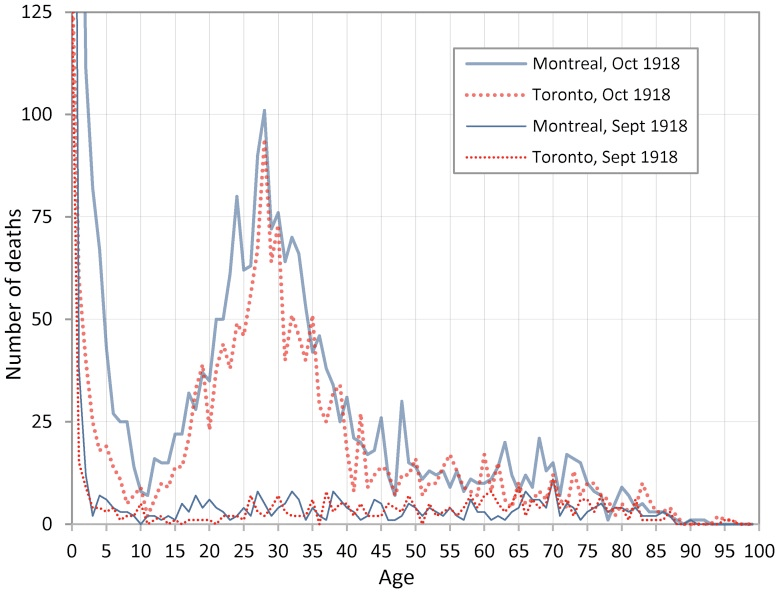
Still, despite the catastrophic death toll of the Spanish Flu being disproportionately born by the working-age population, the National Bureau of Economic Research calculated that the 1918 influenza precipitated only a “a 1.5 percent decline in GDP and a 2.1 percent drop in consumption.” That’s significantly less than the 2020’s decrease in real gross domestic product of 9.5 percent.
This unpredictable data raises an obvious question: what explains the severity of America’s current economic crisis given our much better performance during the Spanish Flu? The NBER researchers proffer, albeit trepidatiously and vaguely, the following explanation:
“… some of the mitigation efforts that are currently underway, particularly those affecting commerce and travel, are likely to amplify the virus’s impact on economic activity.” (Italics our own)
National comparisons between states with similar per capita rates of Covid-19 cases and deaths, but significantly disparate rates of unemployment and lockdown stringency scores substantiate this assertion.
In 2008 the St. Louis Federal Reserve produced a warning that another Spanish Flu-style pandemic would have dire economic consequences, but such a prediction was likely made without factoring in the possibility of lockdowns. They write
“However, for a pandemic as severe as the 1918 influenza, estimates of its overall economic impact range from a 4.25 to a 5.5 percent annual decline in GDP—an effect large enough to trigger a significant recession.”
To reiterate, Covid-19 is by no means as deadly as the Spanish Flu by any stretch of the imagination. The economic contraction was 9.5% not 5.5%.
A National Comparison: Stringency, Unemployment, Covid-19 Deaths
Across the U.S. various state governments have taken different measures in response to the coronavirus pandemic. States such as New York, California, and Massachusetts issued wide-ranging executive orders shuttering businesses, mandating social distancing, and mask-wearing early on in the pandemic, whereas states like South Dakota, Utah, and Florida have largely abstained from imposing top-down controls on their citizens. The difference in these states’ restrictive measures is reflected in their stringency scores as of January 2021, calculated by the University of Oxford: 69.91 (NY), 63.43 (CA), 69.44 (MA), 9.26 (South Dakota), 35.19 (Utah), 33.8 (Florida).
In her recent piece, “The Florida Versus California Shutdown,” Amelia Janaskie details the demographic similarities between the two states and explains the stark difference in the governors’ Covid-19 responses and the resulting discrepancy in economic performance between the two states. Janaskie documents that Florida has kept in-person K-12 schooling open throughout the pandemic, has enforced no mandatory travel quarantine, and imposed no statewide capacity restrictions on restaurants. On the other hand, she underscores that California has adopted all of these aforementioned policies to a particularly severe and protracted degree.
Consequently, Florida has a stringency score of 33.8 whereas California has one of 58.8. Despite their starkly juxtaposed responses, California and Florida have similar Covid cases and deaths per 100,000 population: 119 vs. 135 and 8,621 vs. 8,370, respectively. Despite Florida having a significantly higher at-risk, elderly (65+ years old) population than California, 16.5% vs. 14.8%, California actually experienced more nursing home deaths per 100 residents than Florida: 2 vs. 1.
The major difference between Florida and California? Unemployment: Florida’s rate is 6.1% while California’s is a whopping 9%.
Thomas Hogan explains how this trend manifests across the U.S. in his piece, “Only Ending Lockdowns Can Stimulate the Economy.” He details that, as of January 2021, ten states achieved record low unemployment rates as low as 4%, the likes of which have been seen at a national level only five times since the Great Depression. Conversely, Hogan notes that six states and Washington, D.C. have historically high unemployment rates greater than 8%, which have only been experienced at the national level three times since the Great Depression. Of the ten states with historically low unemployment, nine are in the bottom half of the Oxford COVID-19 Government Response Tracker (CGRT) whereas, of the seven regions with historically high unemployment, five are in the top half of the index.
As discussed by Vincent Geloso in his piece, “Spanish Flu Was Awful But We Moved On Anyway,” these findings confirm the conclusion of an analysis published in the European Journal of Political Economy
“that studied 212 economic crises in 175 countries between 1993 and 2010 [and] found that it is the countries with institutions that are the most open to competition and entrepreneurial activity that experience the least severe recessions, as well as the quickest recoveries.”
From this we can draw a confident conclusion that it is restrictive lockdown policies and not simply fear of Covid-19 that has caused the economic and social damage seen to this current day.
An International Comparison
Across the world we see the effects of lockdowns, even for countries that were less strict than America and Europe. Asia is a prime example of how lockdowns worldwide helped bring down society across the board. Most Asian countries from Japan to India rank relatively low for deaths per capita compared to North America and Europe. Furthermore, lockdown policies were relatively light-handed and diverse in Asia with Taiwan never declaring a lockdown, Japan using a pseudo-lockdown, and India going into full lockdown. Still, whatever restrictions existed took their toll on their respective economies and those economic shocks were worsened by lockdowns in other countries as international trade and travel ground to a halt. The following data is provided by Deloitte, which shows that the economic damage in Asia even exceeded the 2008 Financial Crisis.
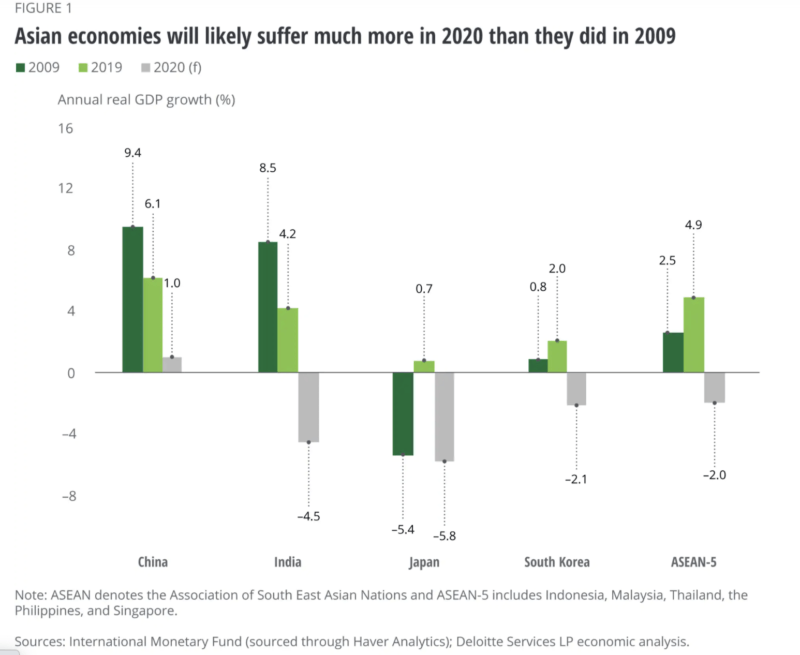
Although fear of Covid-19 may explain some of the economic contraction, it is clear that harsh lockdown policies that prevent society from functioning properly while also exacerbating fear of the virus have caused the strong downturn. This is further demonstrated by the effects of lockdowns in other countries which have subsequent effects on Asian tourism and exports. Those are 2 vital components of the Asian economy. Akrur Barua writes for Deloitte when he notes,
“For economies in South Asia and Southeast Asia that have large tourism sectors, the pandemic and continuing restrictions on travel have meant that tourism incomes have dried up. In Thailand, international tourist arrivals dropped 42.8% in February, 76.4% in March, and then fell to zero in April and May…Smaller and less-diversified economies, such as the Maldives and even Sri Lanka, seem set for a bigger impact on growth…
Passenger movements at Changi Airport, Singapore, fell by 99.5% in April and May. Other air travel hubs like Hong Kong and Kuala Lumpur, Malaysia, show similar declines in passenger traffic. According to the International Air Transport Association, passenger traffic for Asia-Pacific airlines is forecasted to fall 53.8% in 2020, thereby leading to a 27.5% fall in revenues.”
Provided below is a graph detailing the severe drop in tourism in key areas.
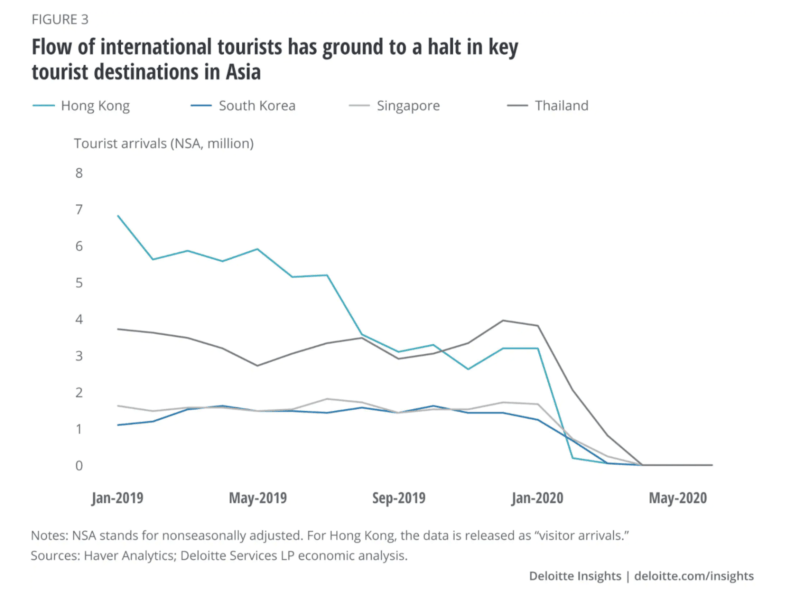
Furthermore, Asia’s export sector has been devastated by lack of demand as economies across the world are shuttered and global supply chains are undone.
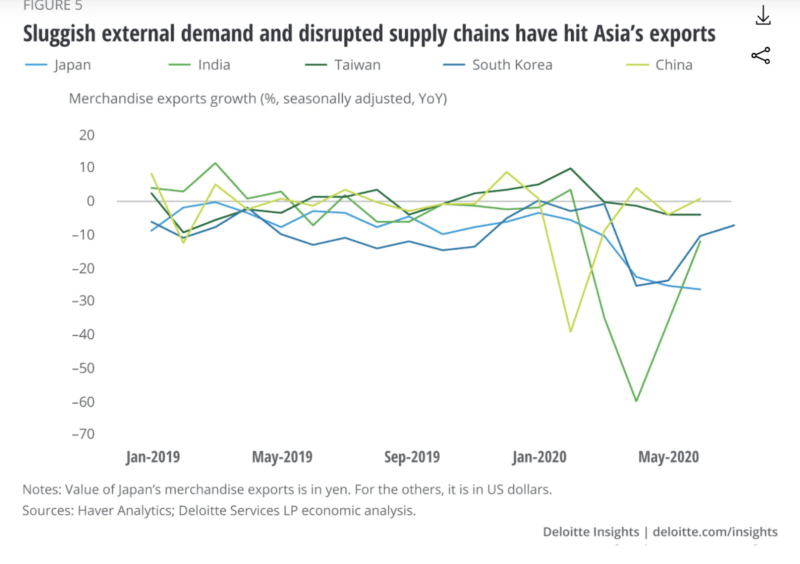
All of these countries rely heavily on external demand for manufactured goods, whether it be garments from India or semiconductors from Taiwan. Lockdowns not just in Asia but across the world have artificially closed off supply lines and suppressed consumer demand, which has clearly culminated in a devastating hit to the Asian export sector.
In poorer countries like Nepal and Bangladesh, lockdowns have caused spikes in food insecurity following the harvest period which is when such rates are historically lower.
Covid-19 lockdowns have created the largest economic contraction in recent history. Greater than the 2008 Financial Crisis, Swine Flu, and, in the context of the U.S., over six times worse than the economic impact of the 1918 Spanish Flu (a contraction of 9.5% in real GDP compared to 1.5%). Unlike a financial crisis which occurs when the economy is unhealthy and in need of a correction, Covid-19 emerged during a time of global prosperity. It is clear that the independent variable in question is the forced and unprecedented shutdown of society by government force.
Key Takeaways
The Covid-19 pandemic has brought about the greatest economic contraction in modern recorded history not just in the United States but across the world, even greater than the financial crises following the Great Depression. Disease outbreaks certainly lead to declines in economic activity but never at this scale.
To suggest that Covid, not the unprecedented halting of societal activity with the force of government is responsible, would be the height of ignorance. Lockdowns as they have been applied in 2020 have never been implemented in the history of public health and now we have seen why. The data is clear. Lockdowns have caused an unprecedented level of economic damage that has far exceeded any event in modern history be it another pandemic or a financial crisis. That is because unlike any other challenge in history, governments across the world forcefully stopped society from reacting and recovering. It should be uncontroversial and frankly, intellectually honest, to say that it was lockdowns that caused the misery that we were forced to endure, not Covid-19.
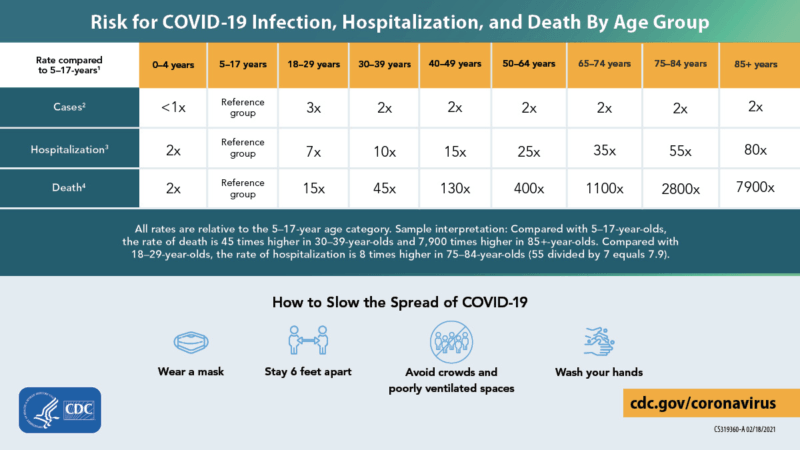


No comments:
Post a Comment